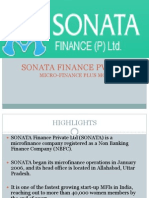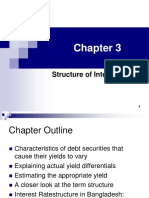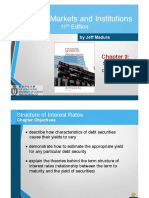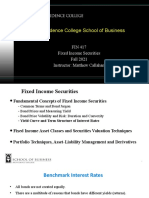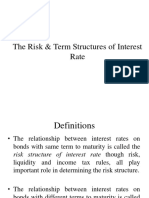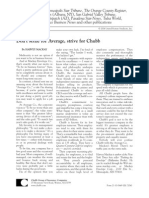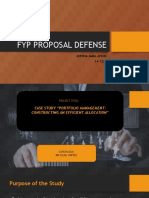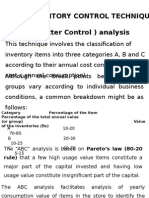Term Structure
Uploaded by
Sam HanzlikTerm Structure
Uploaded by
Sam HanzlikTHE STRUCTURE OF INTEREST RATES
Interest Rate Changes & Differences Between
Interest Rates Can Be Explained by Several
Variables
Term to Maturity.
Default Risk.
Tax Treatment.
Marketability.
Call or Put Features.
Convertibility.
Selected Rates of Interest,
January 1998
Notice that the U.S. Treasury rate is the lowest interest rate in the economy for comparable
maturities.
FINANCIAL SECURITY INTEREST RATE (%)
Commercial Paper, 3 months 4.77
Finance company paper, 3 months 4.81
Bankers Acceptance, 3 months 4.80
U.S. Government Securities:
3-month Treasury bills 4.45
12-month Treasury bills 4.51
5-year Treasury notes 4.60
10-year Treasury bonds 4.72
Aaa municipals (state and local obligations) 5.02
Aaa corporate bonds 6.24
Aa corporate bonds 6.68
A corporate bonds 6.84
Baa corporate bonds 7.29
Source: Federal Reserve statistical release G.13 and Moodys Investor Services.
Term (Maturity) Structure May Be
Studied Visually by Plotting a
Yield Curve at a Point in Time
The yield curve may be ascending, flat, or
descending.
Several theories explain the shape of the yield
curve.
Yield Curves on Treasury
Securities in the 1980s and 1990s
The Expectations Theory
- Interest Rate Expectations Shape the Yield
Curve
The slope of the yield curve reflects investors
expectations about future interest rates.
Ascending: future interest rates are expected to
increase.
Descending: future interest rates are expected to
decrease.
Long-term interest rates represent the geometric average
of current and expected future (implied, forward) interest
rates.
Investors are assumed to trade in a very efficient market
with excellent information and minimal trading costs.
Other theories discussed later presume less efficient
markets.
Term Structure Formula from Expectation
Theory
( ) ( )( )( ) ( ) | |
bond. the of maturity
, applicable is rate the for which period time
rate, forward the
rate, market observed the
: where
1 1 1 1 1
1
1 1 1 2 1 1 1
=
=
=
=
+ + + + = +
+ + +
n
t
f
R
f f f R R
n
n t t t t n t
An Implied One Year Forward Rate from the Term Structure Formula
( )
( )
1
1
1
1
1
1 1
(
(
+
+
=
+
n
n t
n
n t
n t
R
R
f
Finding a One-Year Implied
Forward Rate
Using term structure of interest rates from January 29,
1999, find the one-year implied forward rate for year three.
1-year Treasury bill 4.51%
2-year Treasury note 4.58%
3-year Treasury note 4.57%
( )
( )
4.55% or 0455 . 0 1
0458 . 1
0457 . 1
2
3
1 3
=
(
(
+
+
= f
Liquidity Premium Theory
Long-term securities have greater risk and investors require
greater premiums to give up liquidity.
Long-term securities have greater price variability.
Long-term securities have less marketability.
The liquidity premium explains an upward sloping yield curve.
Market Segmentation Theory
- Maturity preferences may affect security prices (yields),
explaining variations in yields by time
Market participants have strong preferences for securities of
particular maturity and buy and sell securities consistent with
their maturity preferences.
If market participants do not trade outside their maturity
preferences, then discontinuities are possible in the yield curve.
Preferred Habitat Theory
The Preferred Habitat Theory is an extension of the Market
Segmentation Theory.
The Preferred Habitat Theory allows market participants to trade
outside of their preferred maturity if adequately compensated for
the additional risk.
The Preferred Habitat Theory allows for humps or twists in the
yield curve, but limits the discontinuities possible under
Segmentation Theory.
Which Theory is Right?
Day-to-day changes in the term structure are
most consistent with the Preferred Habitat
Theory.
However, in the long-run, expectations of future
interest rates and liquidity premiums are
important components of the position and shape
of the yield curve.
Yield Curves and the Business
Cycle
Interest rates are directly related to the level of
economic activity.
An ascending yield curve notes the market
expectations of economic expansion and/or
inflation.
A descending yield curve forecasts lower rates
possibly related to slower economic growth or
lower inflation rates.
Security markets respond to updated new
information and expectations and reflect their
reactions in security prices and yields.
Interest-Rate and Yield-Curve
Patterns Over the Business Cycle
Default Risk Is the Probability of
the DSU Not Honoring the Security
Contract
Losses may range from interest a few days late
to a complete loss of principal.
Risk averse investors want adequate
compensation for expected default losses.
Investors Charge a Default Risk
Premium (Above Riskless or Less
Risky Securities) for Added Risk
Assumed
DRP = i - i
rf
The default risk premium (DRP) is the difference
between the promised or nominal rate and the
yield on a comparable (same term) riskless
security (Treasury security).
Investors are satisfied if the default risk premium
is equal to the expected default loss.
Risk Premiums for Selected
Securities (January 1999)
Notice that as bond rating quality declines, the default risk premium increases.
SECURITY YIELD EQUIVALENT RISK-FREE RATE
a
RISK PREMIUM
(PERCENT) (PERCENT) (PERCENT) SECURITY
Corporate bonds: Aaa 6.24 5.16 1.08
Corporate bonds: Aa 6.68 5.16 1.52
Corporate bonds: A 6.84 5.16 1.68
Corporate bonds: Baa 7.29 5.16 2.13
a
Thirty-year Treasury bond yield.
Source: Moodys Investor Services, January, 1999.
Default Risk Premiums Increase
(Widen) in Periods of Recession
and Decrease in Economic
Expansion
In good times, risky security prices are bid up;
yields move nearer that of riskless securities.
With increased economic pessimism, investors
sell risky securities and buy quality widening the
DRP.
Credit Rating Agencies Measure
and Grade Relative Default Risk
Among DSUs and Their
Securities
Cash flow, level of debt, profitability, and
variability of earnings are indicators of default
riskiness.
As conditions change, rating agencies alter rating
of businesses and governmental debtors.
Corporate Bond-Rating Systems
Investment grade quality bonds are those rated Baa or above by Moodys (or BBB by Standard and Poors). Financial institutions are typically
allowed to purchase only investment grade securities.
EXPLANATION MOODYS
STANDARD
& POORS
DEFAULT RISK
PREMIUM
Best quality, smallest degree of risk Aaa AAA Lowest
High quality, slightly more long-term risk than top rating Aa1
Aa2
Aa3
AA+
AA
AA-
Upper-medium grade, possible impairment in the future A1
A2
A3
A+
A
A-
Medium grade, lack outstanding investment characteristics Baa1
Baa2
Baa3
BBB+
BBB
BBB-
Speculative issues, protection may be very moderate Ba1
Ba2
Ba3
BB+
BB
BB-
Very speculative, may have small assurance of interest and
principal payments
B1
B2
B3
B+
B
B-
Issues in poor standing, may be in default Caa CCC
Speculative in a high degree, with marked shortcomings Ca CC
Lowest quality, poor prospects of attaining real investment standing C C
D
Highest
Note: The top four rating categories are investment grade binds. Bonds below Baa are speculative grade.
The Taxation of Security Gains
and Income Affects the Yield
Differences Among Securities
The after-tax return, i
at
, is found by multiplying
the pre-tax return by one minus the marginal tax
rate.
i
at
= i
bt
(1-t)
Municipal bond interest income is tax exempt.
Coupon income and capital gains have been
taxed differently in the past, but are now both
taxed at the same rate as ordinary income.
Should You Buy a Municipal or a
Corporate Bond?
0% 7% 10(1 - 0.00) = 10.0%
10 7 10(1 - 0.10) = 9.0
20 7 10(1 - 0.20) = 8.0
30 7 10(1 - 0.30) = 7.0
40 7 10(1 - 0.40) = 6.0
50 7 10(1 - 0.50) = 5.0
CORPORATE AFTER-TAX
INVESTORS MARGINAL TAX RATE MUNICIPAL YIELD YIELD
Differences in Marketability Affect
Interest Yields
Marketability -- The costs and rapidity with which
investors can resell a security.
Cost of trade.
Physical transfer cost.
Search costs.
Information costs.
Securities with good marketability have higher
prices (in demand) and lower yields.
Varied Option Provisions May
Explain Yield Differences Between
Securities
An option is a contract provision which gives the
holder the right, but not the obligation, to buy,sell,
redeem, or convert an asset at some specified
price within a defined future time period.
A Call Option Permits the Issuer
(Borrower) to Call (Refund) the
Obligation Before Maturity
Borrowers will call if interest rates decline.
Investors in callable securities bear the risk of
losing their high-yielding security.
With increased call risk, investors demand a call
interest premium (CIP).
CIP = i
c
- i
nc
A callable bond, i
c
, will be priced to yield a higher
return (by the CIP) than a noncallable, i
nc
, bond.
A Put Option Permits the Investor
(Lender) to Terminate the Contract
at a Designated Price Before
Maturity
Investors are likely to put their security or loan
back to the borrower during periods of increasing
interest rates. The difference in interest rates
between putable and nonputable contracts is
called the put interest discount (PID).
PID = i
p
- i
np
The yield on a putable bond, i
p
, will be lower than
the yield on the nonputable bond, i
np
, by the PIP.
A Conversion Option Permits the
Investor to Convert a Security
Contract Into Another Security
Convertible bonds generally have lower yields,
i
con
, than nonconvertibles, i
ncon
.
The conversion yield discount (CYD) is the
difference between the yields on convertibles
relative to nonconvertibles.
CYD = i
con
- i
ncon
. Investors accept the lower yield
on convertible bonds because they have an
opportunity for increased rates of return through
conversion.
You might also like
- Series A Share Purchase Agreement - Template-1No ratings yetSeries A Share Purchase Agreement - Template-117 pages
- WOL N7C34 PQMCriteria Building EPVaboveBCAB2 1apr13No ratings yetWOL N7C34 PQMCriteria Building EPVaboveBCAB2 1apr1313 pages
- 101 Startup Lessons - An Entrepreneur's Han - George Deeb PDF100% (1)101 Startup Lessons - An Entrepreneur's Han - George Deeb PDF559 pages
- Chapter 2 2 Risk Structure and Term Structure of Interest RatesNo ratings yetChapter 2 2 Risk Structure and Term Structure of Interest Rates38 pages
- 10-Review Determinants of Interest RatesNo ratings yet10-Review Determinants of Interest Rates14 pages
- Chapter-03 - Structure of Interest RatesNo ratings yetChapter-03 - Structure of Interest Rates26 pages
- Lecture 6 - Interest Rates and Bond ValuationNo ratings yetLecture 6 - Interest Rates and Bond Valuation61 pages
- Bond Valuation & Analysis: Concept of Bond Types of Bonds The Yield CurveNo ratings yetBond Valuation & Analysis: Concept of Bond Types of Bonds The Yield Curve28 pages
- Week 12 Risk and Term Structure of Interest RatesNo ratings yetWeek 12 Risk and Term Structure of Interest Rates38 pages
- Chapter 3 - Structure of Interest RatesNo ratings yetChapter 3 - Structure of Interest Rates34 pages
- Chapter 5 - How Do Risk and Term Structure Affect Interest Rates0% (1)Chapter 5 - How Do Risk and Term Structure Affect Interest Rates59 pages
- Lecture 3 - Risk and Term Structure of Interest RatesNo ratings yetLecture 3 - Risk and Term Structure of Interest Rates45 pages
- Interest Rates and Bond Valuation Chapter 6No ratings yetInterest Rates and Bond Valuation Chapter 629 pages
- Topic 4 - Cost of Money & Determinants of Interest RateNo ratings yetTopic 4 - Cost of Money & Determinants of Interest Rate14 pages
- Chapter 2. Interest Rate and Risk PremiumNo ratings yetChapter 2. Interest Rate and Risk Premium26 pages
- Financial Markets: Chapter 2 & 6 The Financial Environment: Markets, Institutions, and Interest RatesNo ratings yetFinancial Markets: Chapter 2 & 6 The Financial Environment: Markets, Institutions, and Interest Rates8 pages
- Chapter 10 - Risk and Term Structure of Interest RatesNo ratings yetChapter 10 - Risk and Term Structure of Interest Rates28 pages
- Fixed Income Securities: A Beginner's Guide to Understand, Invest and Evaluate Fixed Income Securities: Investment series, #2From EverandFixed Income Securities: A Beginner's Guide to Understand, Invest and Evaluate Fixed Income Securities: Investment series, #2No ratings yet
- Providence College School of Business: FIN 417 Fixed Income Securities Fall 2021 Instructor: Matthew CallahanNo ratings yetProvidence College School of Business: FIN 417 Fixed Income Securities Fall 2021 Instructor: Matthew Callahan51 pages
- Unit 3 - Term Structure of Interest Rates Slides 2022No ratings yetUnit 3 - Term Structure of Interest Rates Slides 202253 pages
- Topic 1_Overview of Financial Environment_3No ratings yetTopic 1_Overview of Financial Environment_34 pages
- Lecture 4 - The Term Structure of Interest RatesNo ratings yetLecture 4 - The Term Structure of Interest Rates14 pages
- 5c. The Risk and Term Structure of Interest RatesNo ratings yet5c. The Risk and Term Structure of Interest Rates23 pages
- International Business: by Charles W.L. HillNo ratings yetInternational Business: by Charles W.L. Hill17 pages
- Zivot - Introduction To Computational Finance and Financial Econometrics50% (2)Zivot - Introduction To Computational Finance and Financial Econometrics188 pages
- SEC Filing From Article: Granite Resources, LLC Files Form D With The SECNo ratings yetSEC Filing From Article: Granite Resources, LLC Files Form D With The SEC4 pages
- Advanced Accounting: Akuntansi Keuangan Lanjutan SEMESTER GASAL 2015/2016No ratings yetAdvanced Accounting: Akuntansi Keuangan Lanjutan SEMESTER GASAL 2015/20167 pages
- WOL N7C34 PQMCriteria Building EPVaboveBCAB2 1apr13WOL N7C34 PQMCriteria Building EPVaboveBCAB2 1apr13
- 101 Startup Lessons - An Entrepreneur's Han - George Deeb PDF101 Startup Lessons - An Entrepreneur's Han - George Deeb PDF
- Chapter 2 2 Risk Structure and Term Structure of Interest RatesChapter 2 2 Risk Structure and Term Structure of Interest Rates
- Bond Valuation & Analysis: Concept of Bond Types of Bonds The Yield CurveBond Valuation & Analysis: Concept of Bond Types of Bonds The Yield Curve
- Chapter 5 - How Do Risk and Term Structure Affect Interest RatesChapter 5 - How Do Risk and Term Structure Affect Interest Rates
- Lecture 3 - Risk and Term Structure of Interest RatesLecture 3 - Risk and Term Structure of Interest Rates
- Topic 4 - Cost of Money & Determinants of Interest RateTopic 4 - Cost of Money & Determinants of Interest Rate
- Financial Markets: Chapter 2 & 6 The Financial Environment: Markets, Institutions, and Interest RatesFinancial Markets: Chapter 2 & 6 The Financial Environment: Markets, Institutions, and Interest Rates
- Chapter 10 - Risk and Term Structure of Interest RatesChapter 10 - Risk and Term Structure of Interest Rates
- Fixed Income Securities: A Beginner's Guide to Understand, Invest and Evaluate Fixed Income Securities: Investment series, #2From EverandFixed Income Securities: A Beginner's Guide to Understand, Invest and Evaluate Fixed Income Securities: Investment series, #2
- Providence College School of Business: FIN 417 Fixed Income Securities Fall 2021 Instructor: Matthew CallahanProvidence College School of Business: FIN 417 Fixed Income Securities Fall 2021 Instructor: Matthew Callahan
- Unit 3 - Term Structure of Interest Rates Slides 2022Unit 3 - Term Structure of Interest Rates Slides 2022
- Zivot - Introduction To Computational Finance and Financial EconometricsZivot - Introduction To Computational Finance and Financial Econometrics
- SEC Filing From Article: Granite Resources, LLC Files Form D With The SECSEC Filing From Article: Granite Resources, LLC Files Form D With The SEC
- Advanced Accounting: Akuntansi Keuangan Lanjutan SEMESTER GASAL 2015/2016Advanced Accounting: Akuntansi Keuangan Lanjutan SEMESTER GASAL 2015/2016

